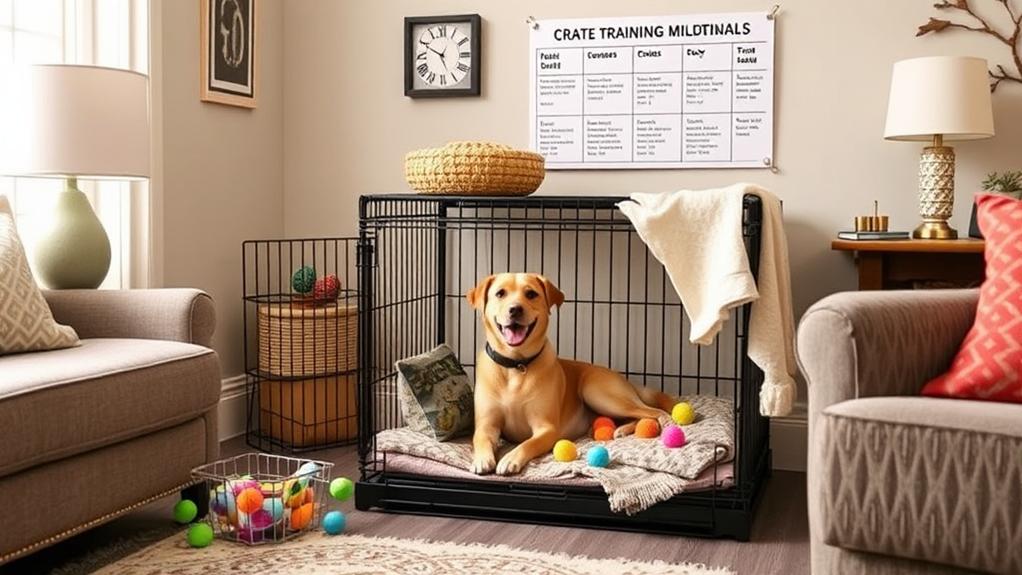Mastering dog crate training is key to ensuring your furry friend feels secure and happy. Start by understanding your dog's behavior and choosing the right crate size and type. Create a positive experience by encouraging exploration with treats and praise. Use a gradual training process, starting with short periods of crate time and extending them as your dog adapts. Be patient with challenges like reluctance or excessive barking, and always reward quiet behavior. Consistency is essential, so stick to a routine. Stick around to discover more tips and tricks for successful crate training!
Understanding Dog Behavior
Understanding dog behavior is crucial for effective crate training. When you grasp how your dog thinks and feels, you can create a positive experience that encourages comfort and security in the crate. Dogs are naturally den animals, so they often seek small, enclosed spaces for safety. Your job is to help them see the crate as their haven.
Pay attention to your dog's body language. Signs of stress, like whining or pacing, indicate they might not feel secure. Instead of forcing them into the crate, allow them to explore it willingly. Use treats or toys to create a positive association. When your dog enters the crate on their own, praise them enthusiastically.
Establish a routine to help your dog adjust. Consistent feeding and potty schedules will ease anxiety and foster trust. Remember, patience is key. Every dog is different, and some may take longer to adapt than others. By understanding your dog's individual personality and needs, you can tailor your approach and build a strong bond. This guarantees crate training isn't just about confinement, but a safe space your dog loves to retreat to.
Choosing the Right Crate

Selecting the right crate is essential for successful crate training. Consider your dog's size, breed, and personality when making your choice. Crates come in various styles and materials, and each has its advantages.
Here's a quick comparison to help you decide:
| Crate Type | Best For |
|---|---|
| Wire Crates | Large breeds and ventilation |
| Plastic Crates | Travel and security |
| Soft-Sided Crates | Small dogs and portability |
When measuring your dog, guarantee that the crate provides enough space for them to stand, turn around, and lie down comfortably. A crate that's too large can encourage your dog to use one end as a bathroom, while one that's too small can cause anxiety.
You should also think about where you'll place the crate in your home. It should be a cozy spot, away from direct sunlight or drafty areas. A well-chosen crate not only keeps your dog safe but also becomes their personal sanctuary. Invest time in selecting a crate that meets your dog's needs, and you'll set the stage for a successful crate training experience.
Creating a Positive Experience
When it comes to crate training, creating a positive experience is essential for your dog's comfort and acceptance of their new space. Start by introducing the crate in a low-pressure way. Place it in a common area where your dog spends time, allowing them to explore it freely. Make the crate inviting by adding soft bedding and a few favorite toys.
Next, use treats to encourage your dog to enter the crate. Toss a treat inside and let them go in at their own pace. Praise them enthusiastically when they do! You want them to associate the crate with positive experiences.
Don't close the door just yet. Instead, let your dog spend short periods inside with the door open, gradually increasing the time as they become more comfortable. Stay nearby during these initial sessions, offering reassurance and treats.
You can also feed your dog their meals in the crate, making it a special place just for them. Remember, patience is key. Celebrate every small step your dog takes toward enjoying their crate, and soon, they'll see it as a safe haven rather than a confinement.
Step-by-Step Training Process

With your dog now feeling comfortable in the crate, it's time to implement a structured training process. Start by introducing short periods where you close the crate door. Begin with just a few minutes, then gradually increase the time your dog spends inside. Always reward them with treats and praise when they enter voluntarily.
Next, practice leaving the room for brief intervals. This helps your dog associate the crate with safety, even when you're not there. If your pup whines or barks, avoid letting them out immediately; wait for a moment of quiet before opening the door.
Once your dog is relaxed during short absences, extend the duration. Aim for 30 minutes to an hour, gradually increasing this time as your dog adjusts.
Incorporate mealtime into the training; feed your dog in the crate to encourage positive associations.
Common Challenges and Solutions

While crate training can be a rewarding experience, you may encounter some common challenges along the way. Understanding these hurdles and how to overcome them will help you and your dog succeed in this important training process.
- Reluctance to Enter the Crate: If your dog hesitates to go inside, try tossing treats or toys into the crate to make it more inviting. Gradually encourage your dog to explore the space at their own pace.
- Excessive Barking or Whining: This can be frustrating, but it's essential not to reward the behavior. Wait for a moment of quiet before letting your dog out. Consistency will teach them that calmness yields rewards.
- Accidents in the Crate: If your dog has an accident, it's often due to improper timing in bathroom breaks. Guarantee your dog is taken out frequently, especially after meals and playtime.
Maintaining Crate Training Success

Maintaining crate training success requires consistency and dedication from you as an owner. To guarantee your dog remains comfortable in their crate, establish a routine. Regular feeding, bathroom breaks, and playtimes help your dog understand when it's time to relax in their crate. Stick to a schedule, and your dog will learn to anticipate these moments.
You should also make the crate a positive space. Use treats, toys, and praise to reinforce your dog's good behavior. If they settle down quietly, reward them to encourage this behavior. Avoid using the crate as a form of punishment, as this could lead to anxiety or fear.
Monitor your dog's comfort level in the crate. If you notice signs of distress, such as excessive barking or whining, reassess the situation. The crate should never feel like a prison; it's their safe haven. Gradually increase the time your dog spends in the crate to help them adjust.
Lastly, remain patient. Crate training is a process, and maintaining success takes time. With your commitment and attention, your dog will thrive in their crate, making both of your lives easier and more enjoyable.
Conclusion
Ultimately, mastering dog crate training can transform your pup's behavior and create a safe space for them. By understanding their needs and following the steps outlined, you'll foster a positive experience that benefits both of you. Remember to be patient and consistent, and don't hesitate to tackle any challenges that arise. With dedication, you'll enjoy a happy, well-adjusted dog who sees the crate as a cozy retreat rather than a confinement. Happy training!



